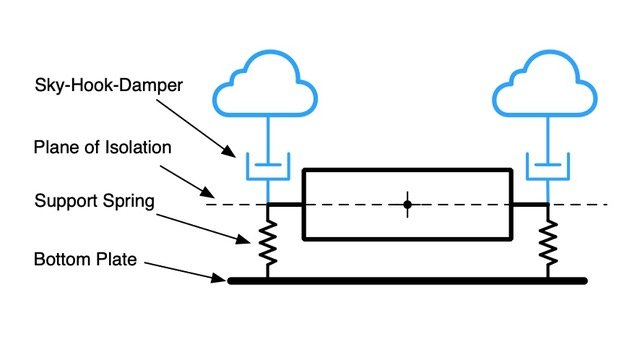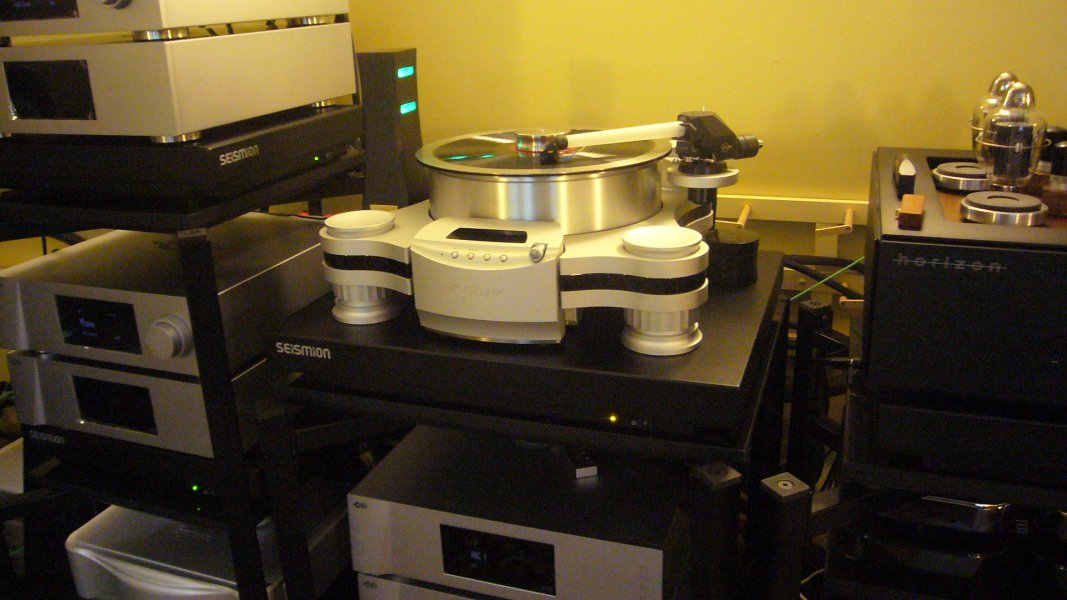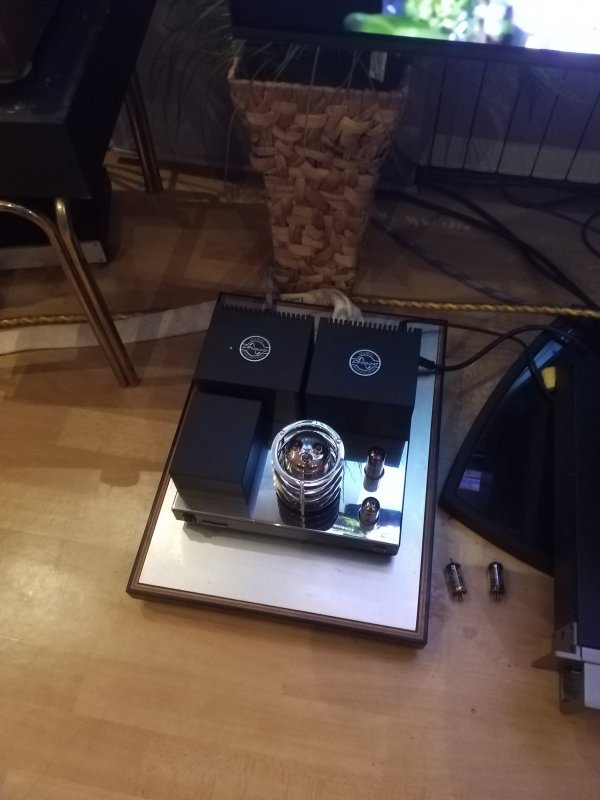SRA and Artesenia Audiowhich are the passive platforms you rate apart from Shun Mooks?
Seismion - new active isolation platform from Germany
- Thread starter TLi
- Start date
You are using an out of date browser. It may not display this or other websites correctly.
You should upgrade or use an alternative browser.
You should upgrade or use an alternative browser.
can't speak to the Seismion products; but with my Takio Tana systems (which are built around the active Herzan/Table Stable TS series units) that is not what i hear. and not only do i hear increased dynamics and life among other musically positive benefits, i also 'see' a higher peak wattage on my dart 468 readout in the same passages at the same volume setting when engaged (verses not engaged) under my turntable.I heard Seismion platforms under a couple of amps and a turntable. I’m sorry to say that but it sucks the life out the music and reduce dynamics dramatically. If you have a bass and/or midbass thumb because of speakers or room you can be fooled by reduced dynamics but it is impossible to like the sound. Surprisingly when you turn it off it starts to sound better. Of course not as good as any other passive platform. I’m glad that it works for many people. Please listen again.
BTW there can be many think that something is wrong with our trial. No, we tried Seismion platforms the correct way, nothing was wrong, no component, speakers, room, electricity or our ears have problems.
this is with the Tana sitting on a solid wood Massif Audio rack with Nordost footers on a 6 inch thick concrete floor.
i use 5 of the Tana systems in my system; two under my dart 468 mono blocks, one under my dart pre, one under my EMIA Phono Corrector and MC Trio, and one under my turntable. they are game changers. you do need to tune any cable connections and unweight them to allow the units to perform optimally. which i do and have posted about. i use the passive RevOpods combined with the Taiko Daiza platforms under my five Wadax chassis which is top flight passive, but i 'wish' a had 4 more Tana systems (or Seismion units) for the Wadax.
Last edited:
I'm equally surprised by your finding. As I've added Seismion tables under my electronics I've heard increased dynamic articulation, both macro and particularly micro, which brings the music more to life and unravels more of the harmonic fabric of the music. I thought I was gilding the lily to put some underneath the signal chassis of my CH Precision M10's, and I was rather surprised by an important increase in life and clean articulation of all musical threads from that move, too. Quite the opposite impact from what you describe.I heard Seismion platforms under a couple of amps and a turntable. I’m sorry to say that but it sucks the life out the music and reduce dynamics dramatically. If you have a bass and/or midbass thumb because of speakers or room you can be fooled by reduced dynamics but it is impossible to like the sound. Surprisingly when you turn it off it starts to sound better. Of course not as good as any other passive platform. I’m glad that it works for many people. Please listen again.
BTW there can be many question that something went wrong with our trial. No, we tried Seismion platforms the correct way, nothing was wrong, no component, speakers, room, electricity or our ears have problems.
If the Seismion is responding to the vibrations generated by the motor and the rotation of the platter how can it then react to environmentally sourced vibrations reaching the turntable? How can it serve three masters? It seems to me that it’s impossible for the Seismion to simultaneously effectively respond to more than one source at a time.The major vibration of turntable comes from the platter. No platter is 100% dynamically balanced. When it turns, it swings. Active isolator can compensate to a several degree this flutter but not much.
The main function of active isolation with turntable is to reduce environmental vibration from feeding back to the record during play. When music is played, the whole room and equipment rack is vibrating with the sound, this creates a feedback loop back to record surface causing a resonant sound. This reduces resolution. The vibration of motor and platter become secondary.
As I said before, active isolator, like Reactio +/- plus, reduces vibration coming from the rack. This reduction is not 100%, although it is close. Adding extra spikes or cones above and below isolator can further fine tune the sound, but again this is secondary.
I am not responding to this thread to just stir the pot, I have a serious interest in active isolation for my Esoteric T1 turntable. To make the equation even more interesting- the T1 has a built in passive suspension.
I’m glad Tana systems work well with your setup.i also 'see' a higher peak wattage on my dart 468 readout in the same passages at the same volume setting when engaged (verses not engaged) under my turntable.
IMHO the right way of testing is not comparing the sound between (active platform that you use) active and turned off. The right way is; comparing equipment over active platform and over other passive platform cause active platforms are not made to be operated passively. But anyway we tried Seismion both active and passive and compared when equipment is over another passive platform (Kondo Kaguras over SRA Ohio and over Seismion).
Last edited:
Did you do those tests simply turning Seismion on and off or do all the hassle of moving it to another passive platform?I'm equally surprised by your finding. As I've added Seismion tables under my electronics I've heard increased dynamic articulation, both macro and particularly micro, which brings the music more to life and unravels more of the harmonic fabric of the music. I thought I was gilding the lily to put some underneath the signal chassis of my CH Precision M10's, and I was rather surprised by an important increase in life and clean articulation of all musical threads from that move, too. Quite the opposite impact from what you describe.
If it was a comparison of Seismion on and off it’s not a worthy test although it sounds better when off.
Whatever the case I’m glad that it works for you.
fbhifi, the answer is quite simple:If the Seismion is responding to the vibrations generated by the motor and the rotation of the platter how can it then react to environmentally sourced vibrations reaching the turntable? How can it serve three masters? It seems to me that it’s impossible for the Seismion to simultaneously effectively respond to more than one source at a time.
I am not responding to this thread to just stir the pot, I have a serious interest in active isolation for my Esoteric T1 turntable. To make the equation even more interesting- the T1 has a built in passive suspension.
the Reactio (plus) has several acceleration sensors attached to the top-plate. As written above, the ultimate goal of the active control is to stabilize the top-plate and make it inertially fixed. It does not matter what the source of these vibrations is (either the ground vibrations, or the device on top). In any case it produces counter forces to stop them as much as possible, ultimately serving both goals simultaneously.
This is a figure that describes the idea of sky-hooked damping. You can consider the dampers to be very strong, and eliminating nearly all vibrations:

Heard them many times, both are good but I favor Acapella.Passive base
Acapella fondatio silzenio with Aluminium feets
Finite elemente carbon
Both sounds really good
Finite elemente is so artificial.Passive base
Acapella fondatio silzenio with Aluminium feets
Finite elemente carbon
Both sounds really good
You mean an implementation like this?If the Seismion is responding to the vibrations generated by the motor and the rotation of the platter how can it then react to environmentally sourced vibrations reaching the turntable? How can it serve three masters? It seems to me that it’s impossible for the Seismion to simultaneously effectively respond to more than one source at a time.
I am not responding to this thread to just stir the pot, I have a serious interest in active isolation for my Esoteric T1 turntable. To make the equation even more interesting- the T1 has a built in passive suspension.
I added a Reactio Plus under my T1 about a month ago as an experiment (if it didn't work well, I could use the table in another spot). I'm pleased enough with the sonic results so far. An active vibration canceling table doesn't care where the vibration comes from, or if there are multiple sources - - it simply reacts with a 180º out of phase canceling impulse to steady the top plate that the component rests upon. Acoustical feedback isn't a single sine wave, but a complex "multi-wave" (that FFT can break down to the multiple sine wave components contributing...). Floor borne vibration is also complex (my neighbor hammer drilling in his basement, the truck rolling by on the street, the refridgerator upstairs, etc.). The active vibration table reacts to the net sum of whatever's causing the top plate to shake relative to the base. And it's always complex.
I've been cautioned that a steady impulse from a motor sitting on the table could eventually cause the Reactio Plus to wear out, due to constant and steady work. Seismion assures me that their table is plenty robust enough to handle this situation for the long haul. Sonically, I'm pleased with the results, especially when rockin' the room! The poise and stability that an active vibration solution brings is next level, IME.

you did something wrong, for my the best base i ever heard at homeFinite elemente is so artificial.
Carbofibre < finite elemente
You say used the correct way, but give no details on how it was utilized.I heard Seismion platforms under a couple of amps and a turntable. I’m sorry to say that but it sucks the life out the music and reduce dynamics dramatically. If you have a bass and/or midbass thumb because of speakers or room you can be fooled by reduced dynamics but it is impossible to like the sound. Surprisingly when you turn it off it starts to sound better. Of course not as good as any other passive platform. I’m glad that it works for many people. Please listen again.
BTW there can be many question that something went wrong with our trial. No, we tried Seismion platforms the correct way, nothing was wrong, no component, speakers, room, electricity or our ears have problems.
In Seismion system image there are still points under the seismion as well as under the equipment sitting on the seismion. Were additional devices used in the system you heard. What were the platforms sitting on.
Did you try the Seismion under specific device? A process of elimination? Others have at times noted active isolation does not work well under certain TT. I am only regurgitating and know nothing about this.
Mike also noted strain from cables. My TT has a sprung suspension and I have to lash my cables to alleviate tugging in the corner.
I don't know anything about Seismion, but I would not dismiss it or other active isolation without further review. It may excell over a static stand in certain situations. It may fall behind in others. We don't have enough details. It would be nice if you isolated specific devices and kept record of what the seismion was on and what the gear was on and the affect to the specific piece. Thats more usefull than a carpet dismissal.
Sorry I jumped in. Thanks for the explanation but are you sure it’s a good idea to eliminate all the vibrations since sound is a vibration too. What about cartridge? Everyone knows that when you listen close to the cartridge you can hear what’s playing without even turning amps on. Is it good to eliminate all the vibrations on a turntable? How about under speakers?This is a figure that describes the idea of sky-hooked damping. You can consider the dampers to be very strong, and eliminating nearly all vibrations:
I’m happy for everyone Seismion worked well under their equipment. I wish it would have been the same for us.
Thanks for every opinion! But I’m skeptic. This sounds like the typical topic, that resonances amplify certain frequency regions and avoiding resonances increases resolution and enables even dynamics throughout the frequency range. Both is correct I’d say. I don’t doubt your findings, but I think if amplified resonances lead to better sound, then there’s a need to look for different optimizations at another place first... sucks the life out the music and reduce dynamics dramatically. …
Last edited:
Only the parasitic vibrations from the floor or the motor are eliminated. The vibrations of the cartridge due to the grooves of course remain (the sensors of the active isolation are place inside our top-plate, and not on the cartridge). One could say the isolator removes all "background" noise, and the pure music remains.Sorry I jumped in. Thanks for the explanation but are you sure it’s a good idea to eliminate all the vibrations since sound is a vibration too. What about cartridge? Everyone knows that when you listen close to the cartridge you can hear what’s playing without even turning amps on. Is it good to eliminate all the vibrations on a turntable? How about under speakers?
I’m happy for everyone Seismion worked well under their equipment. I wish it would have been the same for us.
and i'm glad the SRA and Artesenia are working well for you. i did have the SRA Virginia Class platforms (maybe a prototype version) in my system a few years back under my Lamm ML3's. very nice. not owned the Artesenia but respect it.I’m glad Tana systems work well with your setup.
IMHO the right way of testing is not comparing the sound between (active platform that you use) active and turned off. The right way is; comparing equipment over active platform and over other passive platform cause active platforms are not made to be operated passively. But anyway we tried Seismion both active and passive and compared when equipment is over another passive platform (Kondo Kaguras over SRA Ohio and over Seismion).
while working with Taiko in the development of the Tana systems we did measure the Tana Systems not engaged. they are actually quite effective in their passive state, just not at the very lowest resonance frequencies. much better than an untreated shelf.
and no doubt there are degrees of passive support performance.
i do think that with turntables it's hard to generalize as there are simply so many variables. you just have to listen. or 'look' if you can.
There are some passive isolators that work well below 4 Hz. For passive isolators, the only way to get isolation in low frequency range is by reducing the stiffness k, because the eigenfrequency equals f0 = 1 / 2pi * sqrt(k/m). Isolation starts at 1.41 times f0.Am I correct that no passive solution works (enough) below 4Hz?
There are a few special designs that try to achieve (close to) zero stiffness, typically by some prestress elements that create a negative stiffness, which is used to compensate the stiffness of the supporting spring. MinusK is one of such designs.
The disadvantages of these solutions is the lack of stability, as I mentioned before, because the restoring force (stiffness k times displacement) is very low.
I was referring to typical airspring isolators, which have an f0 of 2.5 - 3 Hz probably, and therefore isolation from about 4 Hz.
Similar threads
- Replies
- 1
- Views
- 501
- Replies
- 3
- Views
- 1K
- Replies
- 0
- Views
- 551
Members online
- Pichler
- MRIguy
- sonrock
- orfeo_monteverdi
- tkcha
- five
- ozy
- Argonaut
- Kingsrule
- dcathro
- Mblu
- sjs
- Another Johnson
- Elliot G.
- Daverich4
- audio.bill
- the sound of Tao
- Massimo66
- JimmyJet
- Foxbat
- andromedaaudio
- strapper211
- flowcharts
- sbnx
- kennyb123
- John T
- audiobomber
- Salectric
- MarkusBarkus
- emoonie
- F208Frank
- enochRoot
- DLS
- Trygve
- Mike Lavigne
- Sharok
- CKKeung
- Swen
- PLF
- quest4audio
- Craig56
- Bbock
- WildPhydeaux
- MOTU
- rlevden
- sujay
- Nsxturbo
- khashmi
- MJR
- Cellcbern
Total: 1,629 (members: 76, guests: 1,553)
| Steve Williams Site Founder | Site Owner | Administrator | Ron Resnick Site Co-Owner | Administrator | Julian (The Fixer) Website Build | Marketing Managersing |



